Hot In-Place Recycled Asphalt Mixtures: RAP Analysis, Compaction Characteristics and Field Evaluation
Abstract
1. Introduction
2. Objective and Research Approach
- To propose a novel RAP analysis method, which assesses the applicability of RAP based on variations in voids during the compaction.
- To investigate the compaction characteristics of HIRAM under various compaction parameters.
- The conduct field testing of asphalt pavements before and after recycling to validate the performance advantages of HIR.
3. Materials and Methods
3.1. Raw Materials
3.1.1. RAP
3.1.2. SBS Modified Bitumen
3.1.3. Rejuvenator
3.1.4. Mineral Aggregates
3.1.5. Gradation Design
3.2. Experimental Methods
3.2.1. RAP Analysis Method
3.2.2. Compaction Characteristics Test
3.2.3. Field Test
4. Results and Discussion
4.1. RAP Analysis
4.1.1. Impact of Compaction Parameters
4.1.2. Evaluation Index of the RAP Analysis Method
4.2. Compaction Characteristics of HIRAM
4.2.1. Mix Design
4.2.2. Impact of Factors on Compaction Characteristics
4.3. Field Evaluation
5. Conclusions
6. Future Work
- Future research should aim to broaden the sample scope, incorporating more engineering instances to validate the novel RAP evaluation method. Additionally, comparisons among various HIR construction processes should be conducted to meet the diverse needs of HIRAP construction under different project conditions.
- Despite the conducted field evaluation, the long-term performance and sustainability of HIRAP should be further maintained for follow-up testing to provide more basis for practical engineering applications.
- The compaction-based method is designed to facilitate widespread adoption in construction practices. Its accuracy warrants further validation, particularly in addressing the applicability issues regarding various types and sources of RAP. Developing an analytical framework that applies to diverse categories of RAP constitutes a future research trajectory.
Author Contributions
Funding
Institutional Review Board Statement
Informed Consent Statement
Data Availability Statement
Conflicts of Interest
Appendix A
| Abbreviations | Meaning |
|---|---|
| HIR | Hot in-place recycling |
| RAP | Reclaimed asphalt pavement |
| HIRAP | Hot in-place recycled asphalt pavement |
| HIRAM | Hot in-place recycled asphalt mixture |
| SBS | Styrene-butadiene-styrene |
| RTFOT | Rolling thin film oven test |
| PAV | Pressure aging vessel |
| SMA | Stone matrix asphalt |
| ANOVA | Analysis of variance |
| Parameters | Meaning |
|---|---|
| VV | Volume of voids (%) |
| VMA | Voids in mineral aggregate (%) |
| VFA | Voids filled with asphalt (%) |
| TD | Texture depth (mm) |
| IRI | International roughness index (mm) |
| Theoretical maximum relative density of the asphalt mixture | |
| Relative density of the specimen by bulk volume | |
| Percentage of each aggregate type to the total mass of the asphalt mixture (%) | |
| Synthetic bulk volume relative density of the aggregates | |
| V | The volume of sand (25 cm3) |
| D | The average diameter of spread sand (mm) |
| Pendulum value converted to the standard temperature of 20 °C | |
| Pendulum value measured at the pavement temperature | |
| Temperature correction value | |
| Water permeability coefficient (mL/min) | |
| Water quantity during the first timing (mL) | |
| Water quantity during the second timing (mL) | |
| Time of the first timing (s) | |
| Time of the second timing (s) | |
| DF | Degrees of freedom |
| MS | Mean square |
| F | F-statistic |
| Sig. | Significance level |
References
- Zhang, H.L.; Chen, Z.H.; Xu, G.Q.; Shi, C.J. Evaluation of aging behaviors of asphalt binders through different rheological indices. Fuel 2018, 221, 78–88. [Google Scholar] [CrossRef]
- Gao, Y.M.; Zhang, Y.Q.; Yang, Y.; Zhang, J.H.; Gu, F. Molecular dynamics investigation of interfacial adhesion between oxidised bitumen and mineral surfaces. Appl. Surf. Sci. 2019, 479, 449–462. [Google Scholar] [CrossRef]
- Ma, J.M.; Nivitha, M.R.; Hesp, S.A.M.; Krishnan, J.M. Validation of empirical changes to asphalt specifications based on phase angle and relaxation properties using data from a northern Ontario, Canada pavement trial. Constr. Build. Mater. 2023, 363, 129776. [Google Scholar] [CrossRef]
- Alamri, M.; Lu, Q.; Xin, C. Preliminary Evaluation of Hot Mix Asphalt Containing Reclaimed Epoxy Asphalt Materials. Sustainability 2020, 12, 3531. [Google Scholar] [CrossRef]
- Sha, A.; Jiang, W.; Shan, J.; Wu, W.; Li, Y.; Zhang, S. Pavement structure and materials design for sea-crossing bridges and tunnel: Case study of the Hong Kong–Zhuhai–Macau Bridge. J. Road Eng. 2022, 2, 99–113. [Google Scholar] [CrossRef]
- Riccardi, C.; Losa, M. Recent advances and perspectives in circular bio-binder extender to substitute part of the fossil based binder in asphalt mixture. Constr. Build. Mater. 2024, 410, 134222. [Google Scholar] [CrossRef]
- Pan, Y.Y.; Han, D.D.; Yang, T.; Tang, D.; Huang, Y.X.; Tang, N.X.; Zhao, Y.L. Field observations and laboratory evaluations of asphalt pavement maintenance using hot in-place recycling. Constr. Build. Mater. 2021, 271, 121864. [Google Scholar] [CrossRef]
- Xu, X.X.; Gu, H.R.; Dong, Q.Z.; Li, J.P.; Jiao, S.J.; Ren, J. Quick heating method of asphalt pavement in hot in-place recycling. Constr. Build. Mater. 2018, 178, 211–218. [Google Scholar] [CrossRef]
- Yu, B.; Liu, Q.; Tian, X.; Zhou, L.; Lin, M. Empirical performance models of hot in-place recycling of asphalt pavements. Int. J. Pavement Eng. 2017, 18, 1081–1088. [Google Scholar] [CrossRef]
- Walther, A.; Büchler, S.; Cannone Falchetto, A.; Wang, D.; Riccardi, C.; Wistuba, M.P. Experimental investigation on asphalt mixtures prepared with reclaimed asphalt pavement and rejuvenators based on the BTSV method. Road Mater. Pavement Des. 2019, 20, 1695–1708. [Google Scholar] [CrossRef]
- Wu, W.; Cavalli, M.C.; Jiang, W.; Kringos, N. Differing perspectives on the use of high-content SBS polymer-modified bitumen. Constr. Build. Mater. 2024, 411, 134433. [Google Scholar] [CrossRef]
- Büchner, J.; Wistuba, M.P.; Remmler, T.; Wang, D. On low temperature binder testing using DSR 4 mm geometry. Mater. Struct. 2019, 52, 113. [Google Scholar] [CrossRef]
- Renken, P.; Büchler, S.; Falchetto, A.C.; Wang, D.I.; Wistuba, M.P. Warm Mix Asphalt—A German Case Study. Asph. Paving Technol. 2020, 87, 685–716. [Google Scholar] [CrossRef]
- Hugener, M.; Di, W.; Falchetto, A.C.; Porot, L.; De Maeijer, P.K.; Oreskovic, M.; Sa-da-Costa, M.; Tabatabaee, H.; Bocci, E.; Kawakami, A.; et al. Recommendation of RILEM TC 264 RAP on the evaluation of asphalt recycling agents for hot mix asphalt. Mater. Struct. 2022, 55, 31. [Google Scholar] [CrossRef]
- Wang, H.P.; Zhang, H.; Liu, X.Y.; Apostolidis, P.; Erkens, S.; Skarpas, A.; Leng, Z.; Airey, G. Micromechanics-Based Viscoelasticity Predictions of Crumb Rubber Modified Bitumen Considering Polymer Network Effects. Transp. Res. Rec. 2022, 2676, 73–88. [Google Scholar] [CrossRef]
- Jiang, W.; Zhang, M.; Ren, P.; Xing, C.; Yuan, D.; Wu, W. Development of porous asphalt mixture based on the synthesis of PTEMG and MDI polyurethane asphalt. Constr. Build. Mater. 2024, 411, 134537. [Google Scholar] [CrossRef]
- Yu, B.; Wang, S.Y.; Gu, X.Y.; Ni, F.J.; Liu, Q. Environmental burden evaluation of hot in-place recycling of asphalt pavement based on discrete event simulation. Transp. Res. Part D-Transp. Environ. 2018, 65, 151–160. [Google Scholar] [CrossRef]
- Zhong, H.B.; Huang, W.D.; Yan, C.Q.; Zhang, Y.; Lv, Q.; Sun, L.J.; Liu, L.Y. Investigating binder aging during hot in-place recycling (HIR) of asphalt pavement. Constr. Build. Mater. 2021, 276, 122188. [Google Scholar] [CrossRef]
- Xu, J.; Fan, Z.; Yang, Q.; Lu, G.; Liu, P.; Wang, D. Hydrothermal carbonization of waste wood: Sustainable recycling of biomass by-products and novel performance enhancer for bitumen. Constr. Build. Mater. 2023, 404, 133307. [Google Scholar] [CrossRef]
- Guo, X.-X.; Zhang, C.; Cui, B.-X.; Wang, D.; Tsai, J. Analysis of Impact of Transverse Slope on Hydroplaning Risk Level. Procedia-Soc. Behav. Sci. 2013, 96, 2310–2319. [Google Scholar] [CrossRef]
- Wang, H.P.; Liu, X.Y.; Apostolidis, P.; Wang, D.; Leng, Z.; Lu, G.Y.; Erkens, S.; Skarpas, A. Investigating the High- and Low-Temperature Performance of Warm Crumb Rubber-Modified Bituminous Binders Using Rheological Tests. J. Transp. Eng. Part B-Pavements 2021, 147, 04021067. [Google Scholar] [CrossRef]
- Wang, H.P.; Liu, X.Y.; Zhang, H.; Apostolidis, P.; Erkens, S.; Skarpas, A. Micromechanical modelling of complex shear modulus of crumb rubber modified bitumen. Mater. Des. 2020, 188, 108467. [Google Scholar] [CrossRef]
- Jiang, W.; Li, P.F.; Sha, A.M.; Li, Y.P.; Yuan, D.D.; Xiao, J.J.; Xing, C.W. Research on Pavement Traffic Load State Perception Based on the Piezoelectric Effect. Ieee Trans. Intell. Transp. Syst. 2023, 24, 8264–8278. [Google Scholar] [CrossRef]
- Yuan, D.D.; Jiang, W.; Sha, A.M.; Xiao, J.J.; Wu, W.J.; Wang, T. Technology method and functional characteristics of road thermoelectric generator system based on Seebeck effect. Appl. Energy 2023, 331, 120459. [Google Scholar] [CrossRef]
- Jiang, W.; Yuan, D.D.; Shan, J.H.; Ye, W.L.; Lu, H.H.; Sha, A.M. Experimental study of the performance of porous ultra-thin asphalt overlay. Int. J. Pavement Eng. 2022, 23, 2049–2061. [Google Scholar] [CrossRef]
- Zhang, H.L.; Duan, H.H.; Zhu, C.Z.; Chen, Z.H.; Luo, H. Mini-Review on the Application of Nanomaterials in Improving Anti-Aging Properties of Asphalt. Energy Fuels 2021, 35, 11017–11036. [Google Scholar] [CrossRef]
- Shi, K.; Ma, F.; Fu, Z.; Song, R.; Yuan, D.; Ogbon, A.W. Enhancing aged SBS-modified bitumen performance with unaged bitumen additives. Constr. Build. Mater. 2024, 412, 134768. [Google Scholar] [CrossRef]
- Gao, Y.M.; Zhang, Y.Q.; Gu, F.; Xu, T.; Wang, H. Impact of minerals and water on bitumen-mineral adhesion and debonding behaviours using molecular dynamics simulations. Constr. Build. Mater. 2018, 171, 214–222. [Google Scholar] [CrossRef]
- Ma, J.M.; Hesp, S.A.M.; Chan, S.S.N.; Li, J.Z.; Lee, S.P. Lessons learned from 60 years of pavement trials in continental climate regions of Canada. Chem. Eng. J. 2022, 444, 136389. [Google Scholar] [CrossRef]
- Sha, A.; Liu, Z.; Jiang, W.; Qi, L.; Hu, L.; Jiao, W.; Barbieri, D.M. Advances and development trends in eco-friendly pavements. J. Road Eng. 2021, 1, 1–42. [Google Scholar] [CrossRef]
- Jia, M.; Sha, A.M.; Jiang, W.; Li, X.Z.; Jiao, W.X. Developing a solid-solid phase change heat storage asphalt pavement material and its application as functional filler for cooling asphalt pavement. Energy Build. 2023, 285, 112935. [Google Scholar] [CrossRef]
- Wang, H.P.; Liu, X.Y.; Varveri, A.; Zhang, H.Z.; Erkens, S.; Skarpas, A.; Leng, Z. Thermal aging behaviors of the waste tire rubber used in bitumen modification. Prog. Rubber Plast. Recycl. Technol. 2022, 38, 56–69. [Google Scholar] [CrossRef]
- Wang, T.; Jiang, W.; Xiao, J.J.; Guo, D.D.; Yuan, D.D.; Wu, W.J.; Wang, W.T. Study on the blending behavior of asphalt binder in mixing process of hot recycling. Case Stud. Constr. Mater. 2022, 17, e01477. [Google Scholar] [CrossRef]
- Yuan, D.D.; Xing, C.W.; Jiang, W.; Xiao, J.J.; Wu, W.J.; Li, P.F.; Li, Y.P. Viscoelastic Behavior and Phase Structure of High-Content SBS-Modified Asphalt. Polymers 2022, 14, 2476. [Google Scholar] [CrossRef] [PubMed]
- Yuan, D.D.; Jiang, W.; Xiao, J.J.; Tong, Z.; Jia, M.; Shan, J.H.; Ogbon, A.W. Assessment of the Aging Process of Finished Product-Modified Asphalt Binder and Its Aging Mechanism. J. Mater. Civ. Eng. 2022, 34, 04022174. [Google Scholar] [CrossRef]
- Ma, Y.; Ding, Y.; Zheng, K.; Polaczyk, P.; Zhang, M.; Xiao, R.; Huang, B. Effects of Immobilized RAP Binder on Asphalt-Aggregate Interaction and Performance of 100% Recycled Asphalt Mixtures. J. Mater. Civ. Eng. 2023, 35, 04023029. [Google Scholar] [CrossRef]
- Ali, H.; McCarthy, L.M.; Welker, A. Performance of hot in-place recycled Superpave mixtures in Florida. Constr. Build. Mater. 2013, 49, 618–626. [Google Scholar] [CrossRef]
- Cao, R.J.; Leng, Z.; Hsu, S.C. Comparative eco-efficiency analysis on asphalt pavement rehabilitation alternatives: Hot in-place recycling and milling-and-filling. J. Clean. Prod. 2019, 210, 1385–1395. [Google Scholar] [CrossRef]
- Huang, K.; Xu, T.; Li, G.F.; Jiang, R.L. Heating effects of asphalt pavement during hot in-place recycling using DEM. Constr. Build. Mater. 2016, 115, 62–69. [Google Scholar] [CrossRef]
- Li, X.L.; Lv, X.C.; Zhou, Y.H.; You, Z.P.; Chen, Y.L.; Cui, Z.J.; Diab, A. Homogeneity evaluation of hot in-place recycling asphalt mixture using digital image processing technique. J. Clean. Prod. 2020, 258, 120524. [Google Scholar] [CrossRef]
- Liu, Y.; Wang, H.N.; Tighe, S.L.; Zhao, G.Y.; You, Z.P. Effects of preheating conditions on performance and workability of hot in-place recycled asphalt mixtures. Constr. Build. Mater. 2019, 226, 288–298. [Google Scholar] [CrossRef]
- Ma, Y.T.; Polaczyk, P.; Park, H.; Jiang, X.; Hu, W.; Huang, B.S. Performance evaluation of temperature effect on hot in-place recycling asphalt mixtures. J. Clean. Prod. 2020, 277, 124093. [Google Scholar] [CrossRef]
- JTG E20-2011; Standard Test Methods of Bitumen and Bituminous Mixtures for Highway Engineering. Highway & Transportation Industry Standard: Beijing, China, 2011.
- Zhang, M.; Kou, C.; Kang, A.; Xiao, P.; Hu, H. Microscopic characteristics of interface transition zones of hot mix asphalt containing recycled concrete aggregates. J. Clean. Prod. 2023, 389, 136070. [Google Scholar] [CrossRef]
- Cai, X.; Zhang, Q.; Yu, H.; Huang, W.; Wu, K.; Yang, G.; Bao, X. Study on performance of recycled asphalt mixture based on blending state analysis of virgin and aged asphalt. Int. J. Pavement Eng. 2023, 24, 2165658. [Google Scholar] [CrossRef]
- Yang, C.; Wu, S.; Xie, J.; Amirkhanian, S.; Zhao, Z.; Xu, H.; Wang, F.; Zhang, L. Development of blending model for RAP and virgin asphalt in recycled asphalt mixtures via a micron-Fe3O4 tracer. J. Clean. Prod. 2023, 383, 135407. [Google Scholar] [CrossRef]
- JTG 3450-2019; Field Test Methods of Highway Subgrade and Pavement. Highway & Transportation Industry Standard: Beijing, China, 2019.
- Nizamuddin, S.; Baloch, H.A.; Jamal, M.; Madapusi, S.; Giustozzi, F. Performance of waste plastic bio-oil as a rejuvenator for asphalt binder. Sci. Total Environ. 2022, 828, 8. [Google Scholar] [CrossRef]
- Vazquez, V.F.; Garcia-Hoz, A.M.; Teran, F.; Gil-Abarca, A.; Paje, S.E. Functional characterization of a Cold-In place-Recycled pavement at different stages of the curing process. Sci. Total Environ. 2021, 789, 9. [Google Scholar] [CrossRef] [PubMed]
- Kumar, A.; Choudhary, R.; Kandhal, P.S.; Julaganti, A.; Behera, O.P.; Singh, A.; Kumar, R. Fatigue characterisation of modified asphalt binders containing warm mix asphalt additives. Road Mater. Pavement Des. 2020, 21, 519–541. [Google Scholar] [CrossRef]
- Zhu, Y.J.; Ma, T.; Xu, G.J.; Fan, J.W.; Zhang, Y.M.; Wu, M. Study of the Mixing between Asphalt and Rejuvenator in Hot In-Place Recycled Layer. J. Transp. Eng. Part B-Pavements 2023, 149, 04023005. [Google Scholar] [CrossRef]
- Bouraima, M.B.; Zhang, X.H.; Rahman, A.; Qiu, Y.J. A comparative study on asphalt binder and mixture performance of two traffic lanes during hot in-place recycling (HIR) procedure. Constr. Build. Mater. 2019, 223, 33–43. [Google Scholar] [CrossRef]
- Pan, Y.Y.; Liu, G.Q.; Tang, D.; Han, D.D.; Li, X.G.; Zhao, Y.L. A rutting-based optimum maintenance decision strategy of hot in-place recycling in semi-rigid base asphalt pavement. J. Clean. Prod. 2021, 297, 126663. [Google Scholar] [CrossRef]
- Ma, D.C.; Lan, F. Numerical simulation analysis on multi-layer low-temperature heating method of asphalt pavement in hot in-place recycling. J. Cent. South Univ. 2020, 27, 3793–3806. [Google Scholar] [CrossRef]
- Pan, Y.Y.; Yang, T.; Chen, A.Q.; Li, X.G.; Zhao, Y.L. Determination of Virgin Asphalt Mixture Content in Hot In-Place Recycling Based on Field Rutting Depth Variability. J. Mater. Civ. Eng. 2023, 35, 05023002. [Google Scholar] [CrossRef]
- Liu, Z.M.; Sun, L.J.; Zhai, J.H.; Huang, W.Q. A review of design methods for cold in-place recycling asphalt mixtures: Design processes, key parameters, and evaluation. J. Clean. Prod. 2022, 370, 133530. [Google Scholar] [CrossRef]
- Han, D.D.; Zhao, Y.L.; Pan, Y.Y.; Liu, G.Q.; Yang, T. Heating process monitoring and evaluation of hot in-place recycling of asphalt pavement using infrared thermal imaging. Autom. Constr. 2020, 111, 103055. [Google Scholar] [CrossRef]
- Schwettmann, K.; Nytus, N.; Radenberg, M.; Stephan, D. Ageing behaviour of naturally and artificially aged bitumen samples after the addition of rejuvenators. Road Mater. Pavement Des. 2023, 24, 471–485. [Google Scholar] [CrossRef]
- Purohit, S.; Panda, M.; Das, A.K. Performance of waste polyethylene modified bituminous paving mixes containing reclaimed asphalt pavement and recycled concrete aggregate. Constr. Build. Mater. 2022, 348, 16. [Google Scholar] [CrossRef]
- Hettiarachchi, C.; Hou, X.D.; Xiang, Q.; Yong, D.; Xiao, F.P. A blending efficiency model for virgin and aged binders in recycled asphalt mixtures based on blending temperature and duration. Resour. Conserv. Recycl. 2020, 161, 12. [Google Scholar] [CrossRef]
- Goli, A.; Ziari, H.; Amini, A. Influence of Carbon Nanotubes on Performance Properties and Storage Stability of SBS Modified Asphalt Binders. J. Mater. Civ. Eng. 2017, 29, 9. [Google Scholar] [CrossRef]
- Boom, Y.J.; Enfrin, M.; Grist, S.; Giustozzi, F. Recycled plastic modified bitumen: Evaluation of VOCs and PAHs from laboratory generated fumes. Sci. Total Environ. 2022, 832, 13. [Google Scholar] [CrossRef]



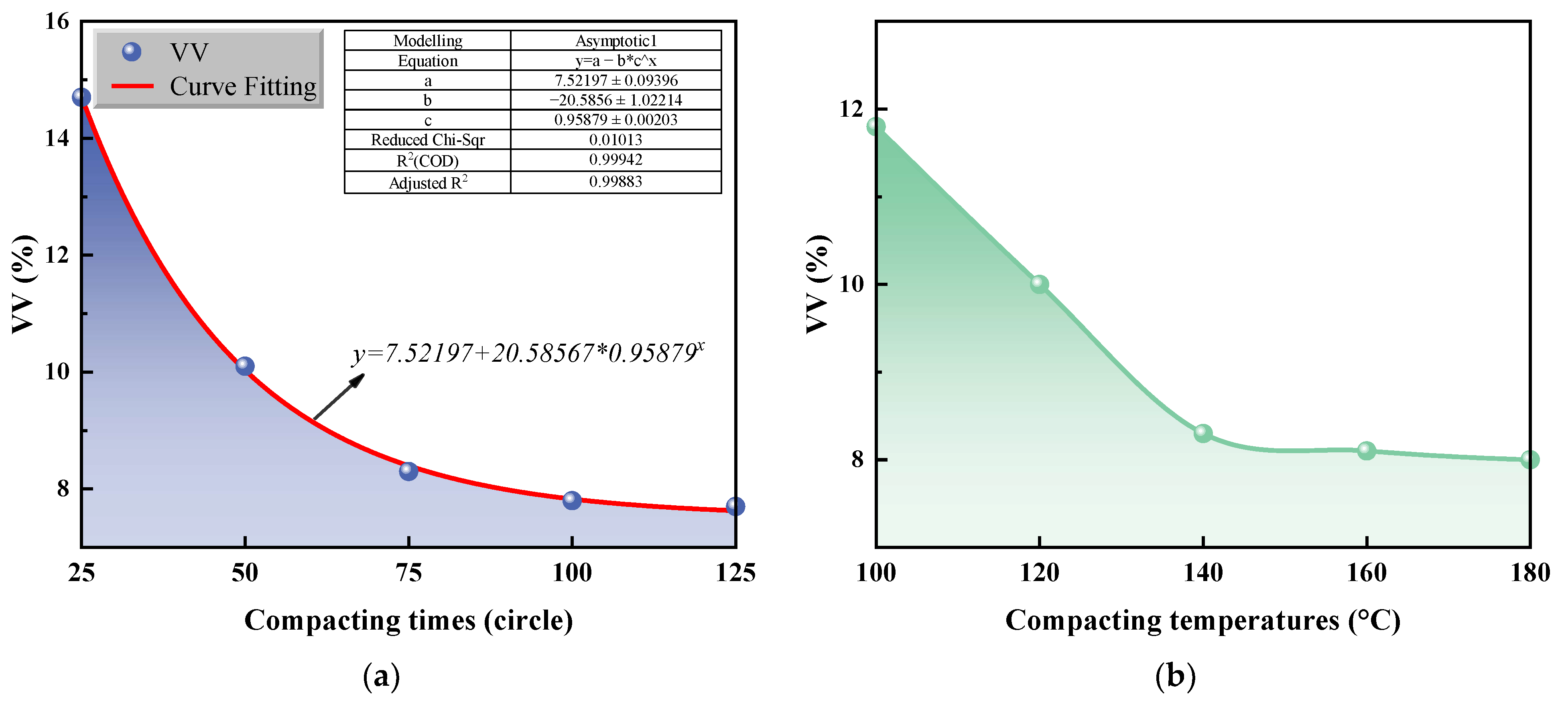
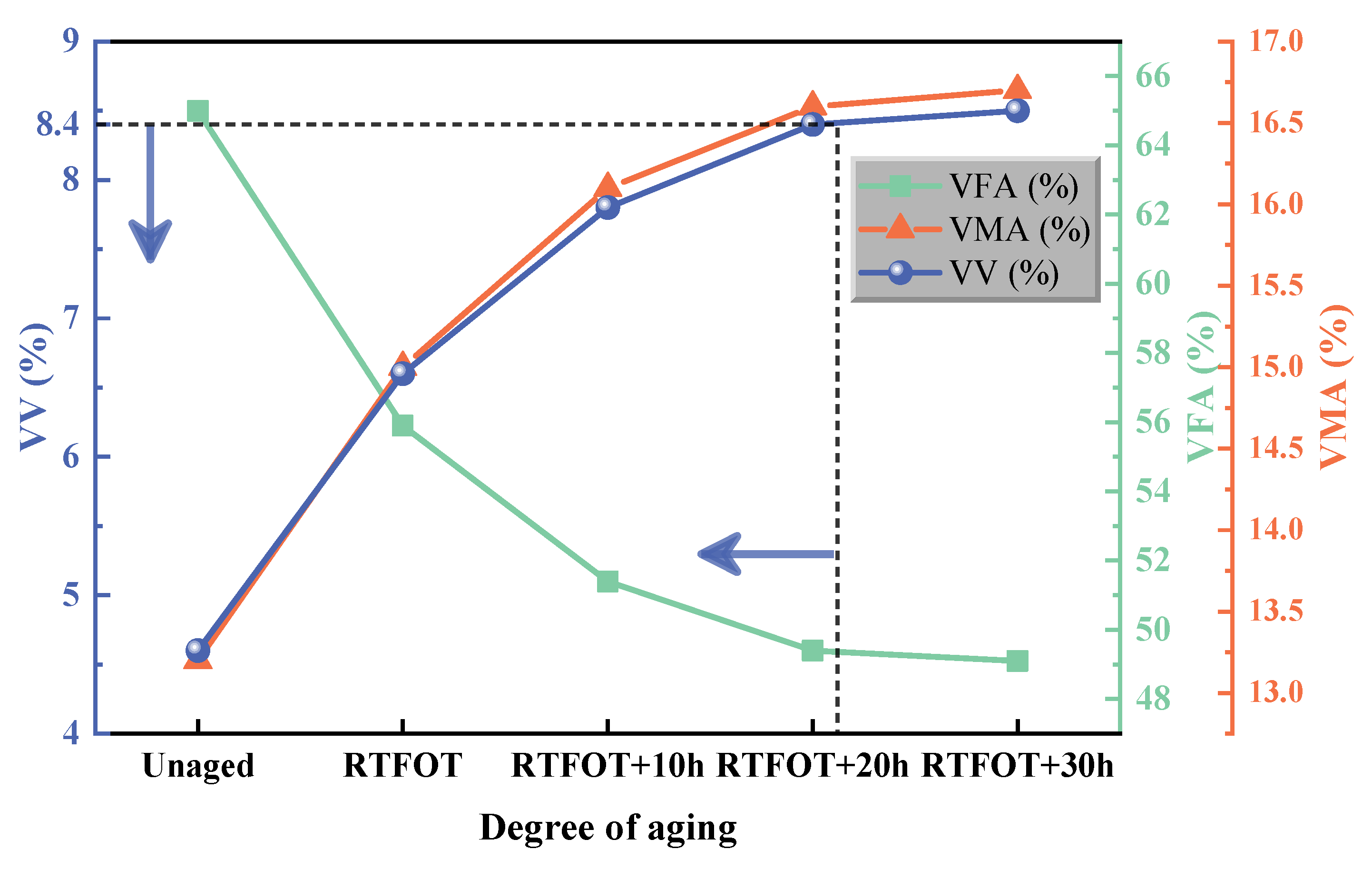

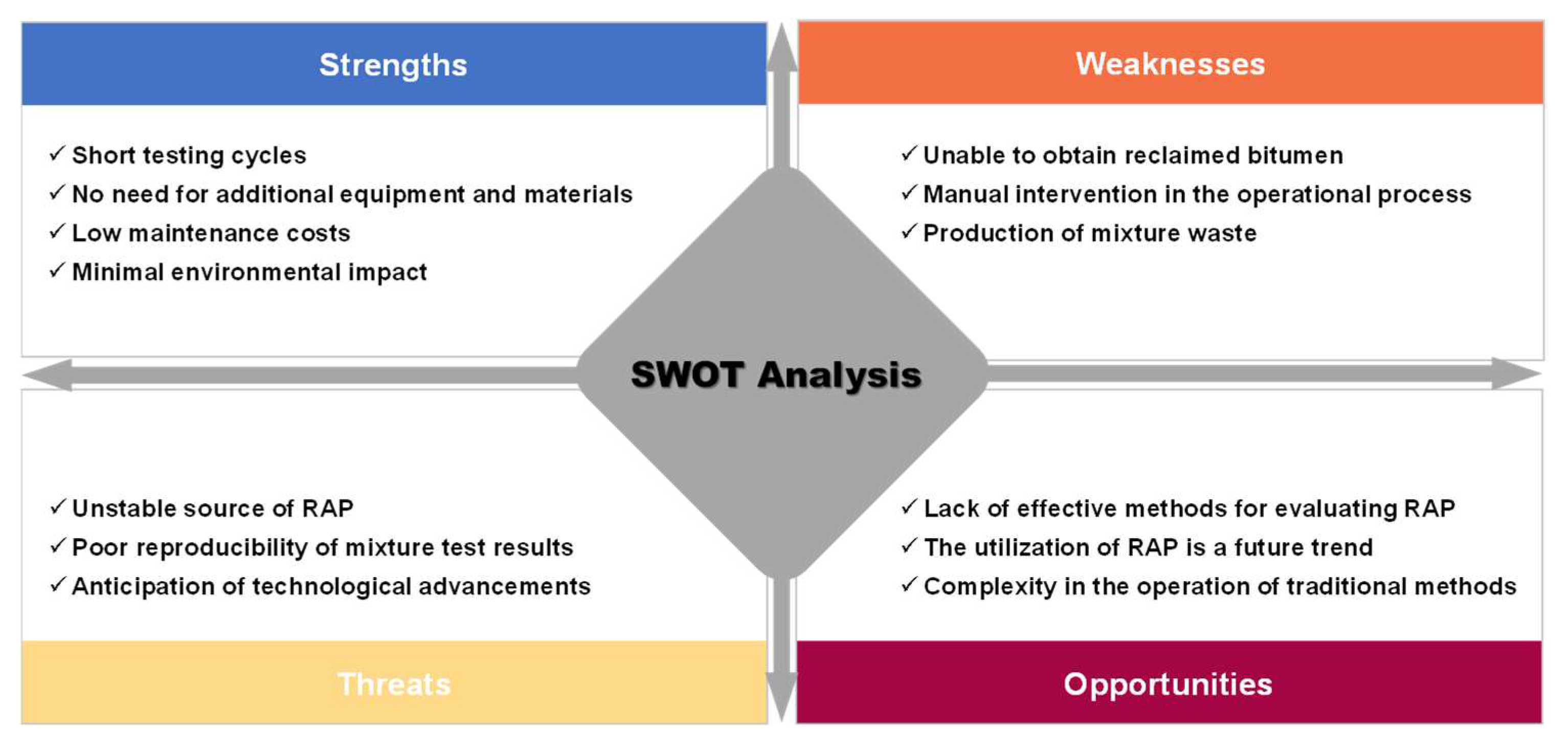
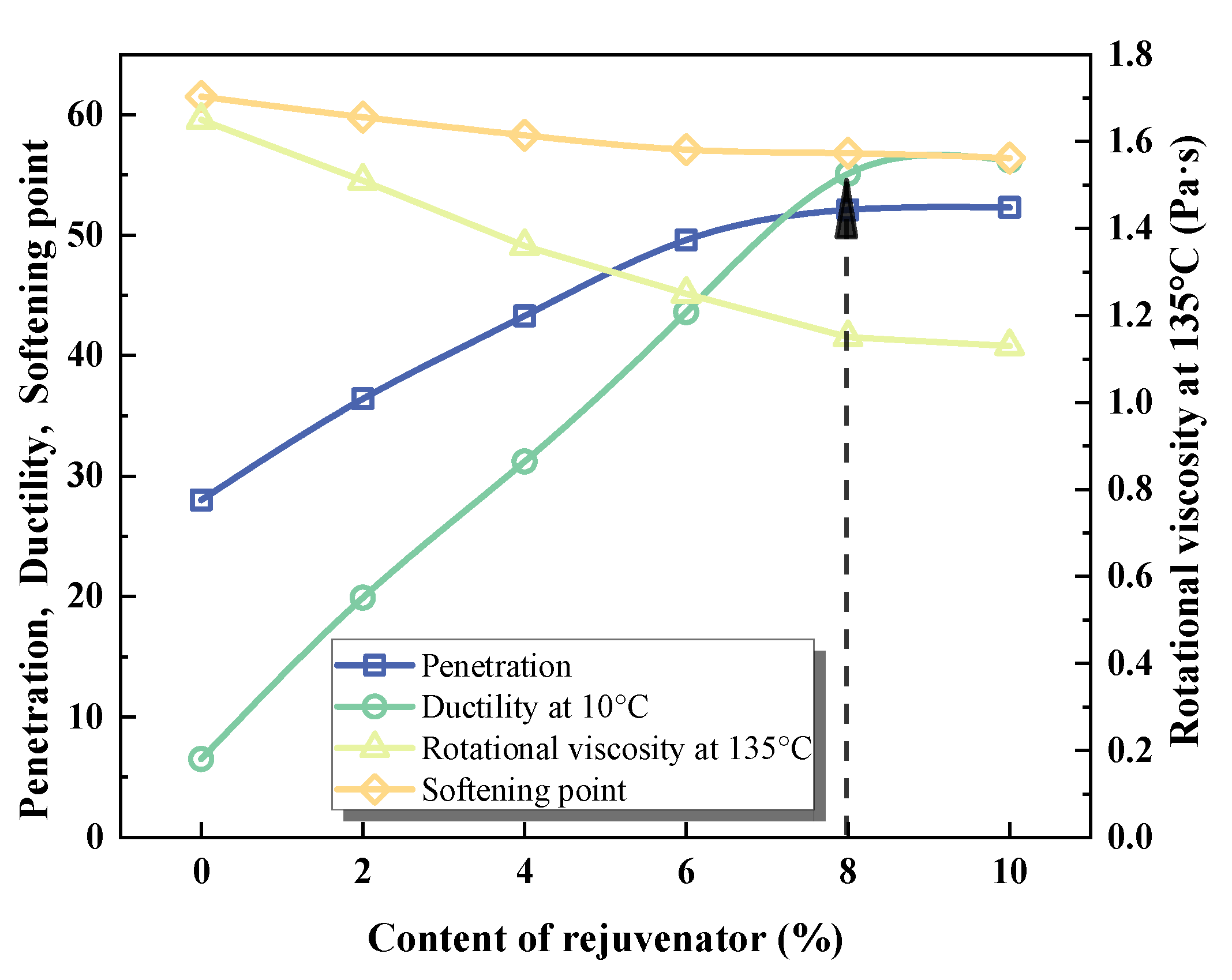
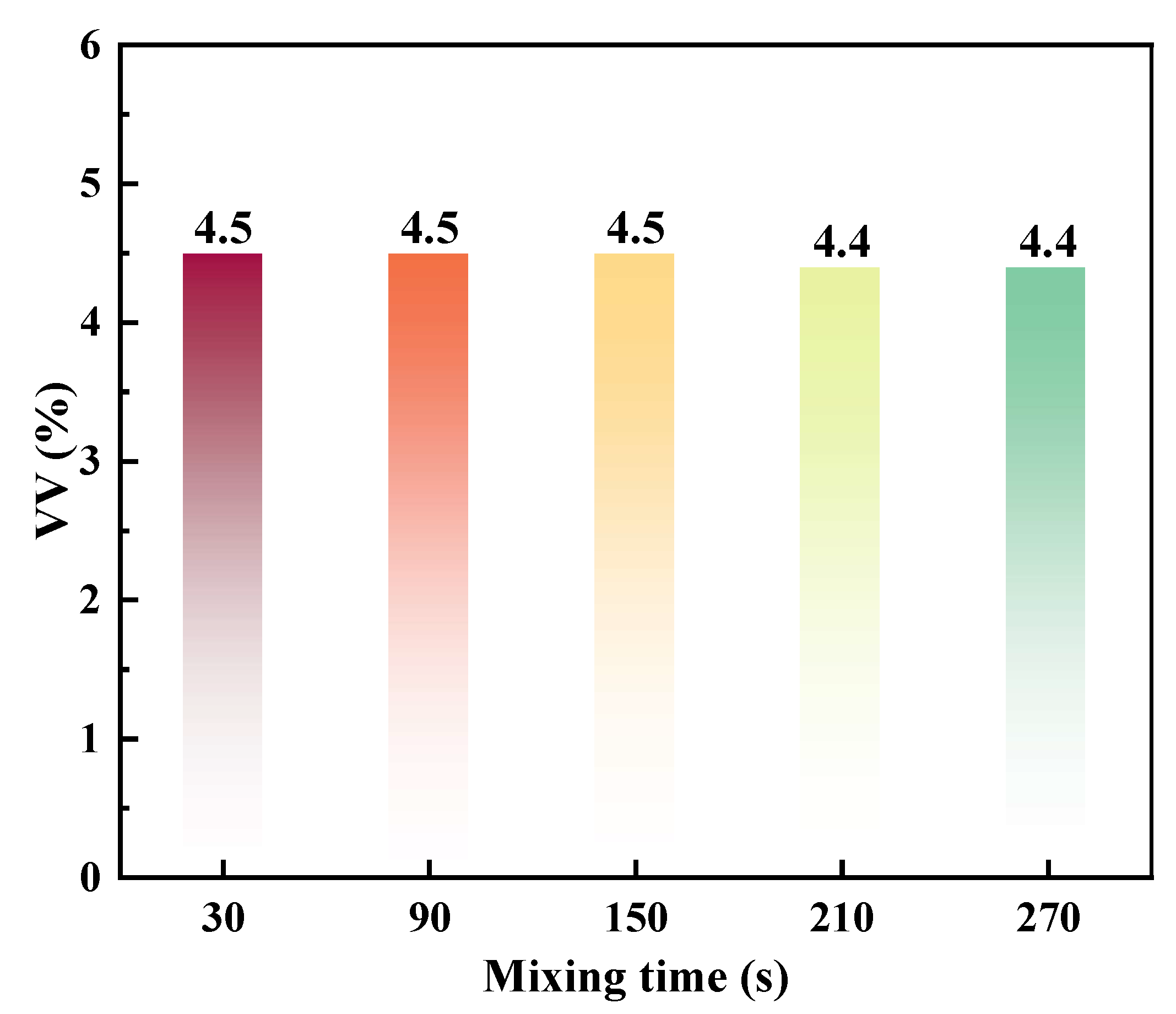
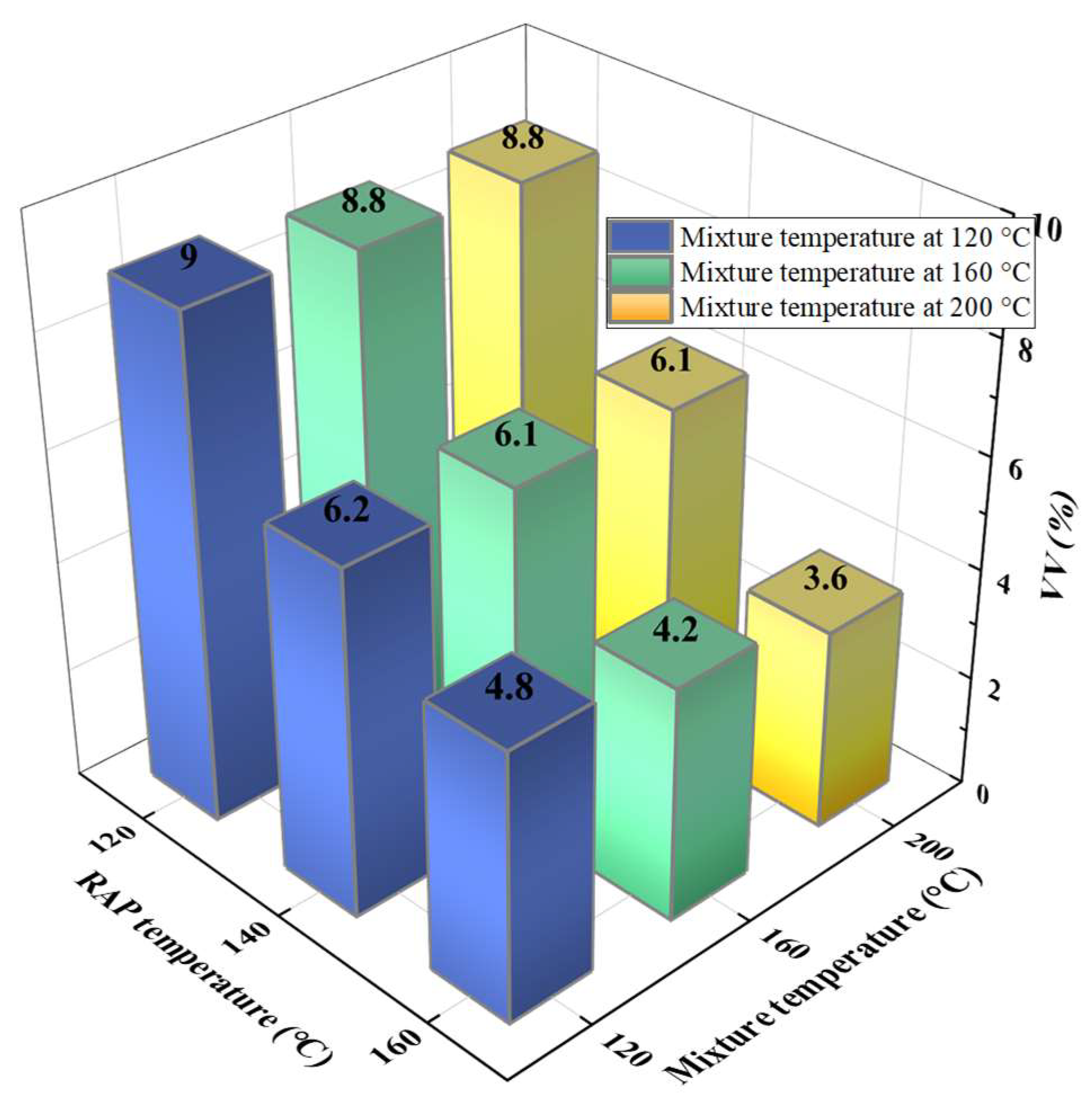
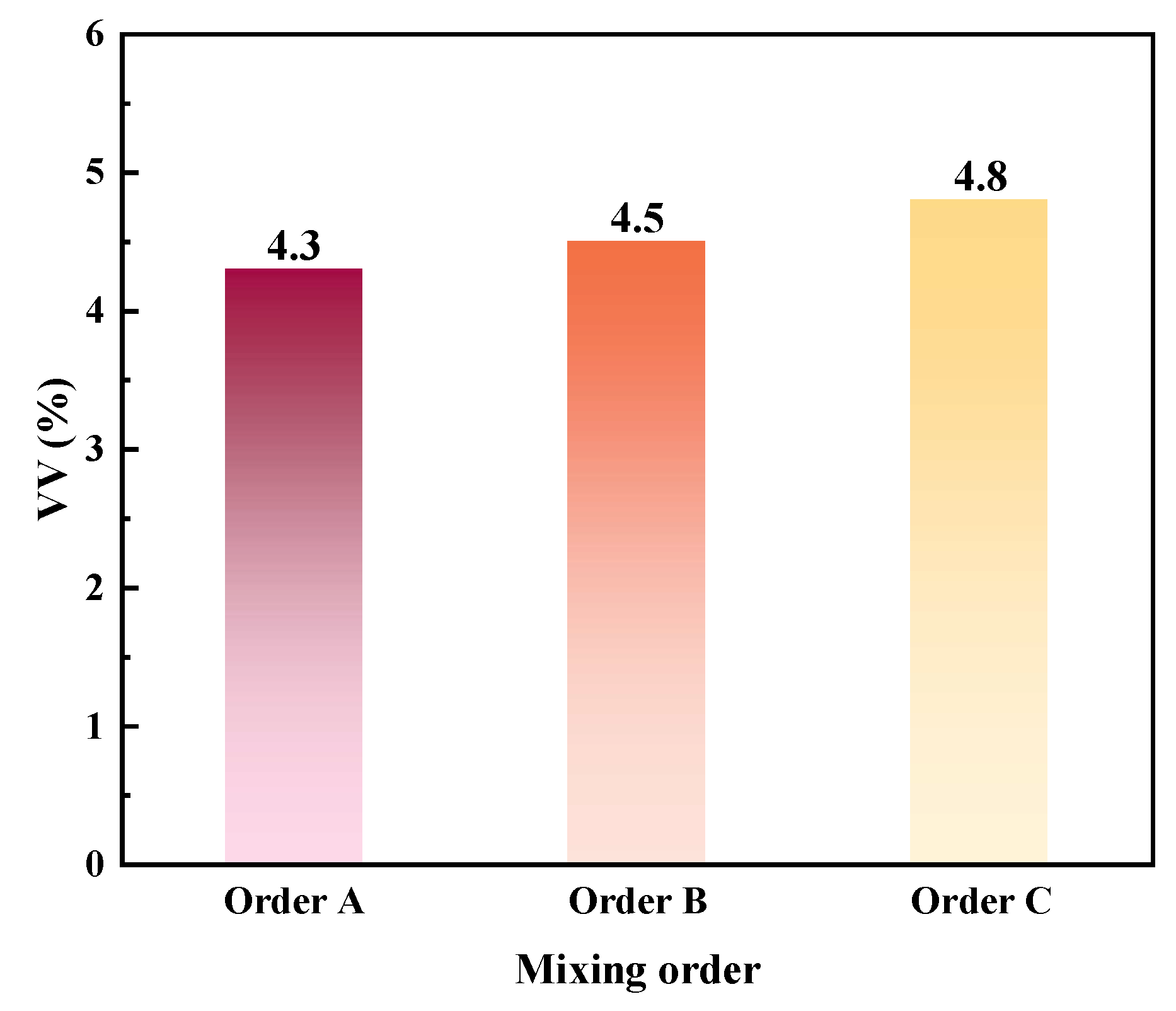

| Technical Index | Unit | Measured Value | Index Requirement |
|---|---|---|---|
| Penetration (25 °C, 5 s, 100 g) | 0.1 mm | 25.5 | 60~80 |
| Ductility (10 °C) | cm | 4.2 | >25 |
| Softening point (ring-and-ball method) | °C | 64.1 | >46 |
| Bitumen content in RAP | % | 5.6 | - |
| Technical Index | Unit | Measured Value | Index Requirement |
|---|---|---|---|
| Penetration (25 °C, 5 s, 100 g) | 0.1 mm | 58.8 | 40~60 |
| Ductility at 5 °C (cm) | cm | 30 | ≥20 |
| Softening point (°C) | °C | 70 | ≥60 |
| Technical Index | Unit | Measured Value | Index Requirement |
|---|---|---|---|
| Dynamic viscosity at 60 °C | mm2/s | 251 | 176~900 |
| Flashing point | °C | 242 | >220 |
| Saturates | % | 28 | ≤30 |
| Aromatics | % | 58 | Measured |
| Mass variation before and after aging | % | 2.6 | ≤3 |
| Technical Index | Unit | Measured Value | Index Requirement | ||
|---|---|---|---|---|---|
| 10–15 mm | 5–10 mm | 0–3 mm | |||
| Bulk density | g/cm3 | 2.75 | 2.84 | 2.69 | Measured |
| Apparent density | g/cm3 | 2.83 | 2.88 | 2.79 | Measured |
| Needle flake content | % | 10.13 | 12.76 | - | ≤15 |
| Crush value | % | 20.88 | - | - | ≤26 |
| Water absorption | % | 1.13 | 0.92 | 1.19 | Measured |
| Wear value | % | 21.98 | - | - | ≤28 |
| Sand equivalent | % | - | - | 72.69 | ≥60 |
| Angularity | s | - | - | 33.62 | ≥30 |
| Sieve Opening (mm) | Gradation Composition (%) | 16 | 13.2 | 9.5 | 4.75 | 2.36 | 1.18 | 0.6 | 0.3 | 0.15 | 0.075 |
|---|---|---|---|---|---|---|---|---|---|---|---|
| 10–15 mm | 9 | 100.0 | 94.5 | 16.1 | 1.8 | 1.8 | 1.8 | 1.8 | 1.8 | 1.8 | 1.7 |
| 5–10 mm | 9 | 100.0 | 100.0 | 96.9 | 12.8 | 0 | 0 | 0 | 0 | 0 | 0 |
| RAP | 80 | 99.7 | 95.5 | 65.8 | 34 | 27.8 | 23 | 18.6 | 14.4 | 12.8 | 10.2 |
| Mineral powder | 2 | 100.0 | 100.0 | 100.0 | 100.0 | 100.0 | 100.0 | 99.8 | 97.8 | 92.7 | 79.1 |
| Lower limit | - | 100.0 | 90.0 | 50.0 | 20.0 | 15.0 | 14.0 | 12.0 | 10.0 | 9.0 | 8.0 |
| Upper limit | - | 100.0 | 100.0 | 75.0 | 34.0 | 26.0 | 24.0 | 20.0 | 16.0 | 15.0 | 12.0 |
| Gradation median | - | 100.0 | 95.0 | 62.5 | 27.0 | 20.5 | 19.0 | 16.0 | 13.0 | 12.0 | 10.0 |
| Composite gradation | 100 | 99.8 | 95.9 | 64.8 | 30.5 | 24.4 | 20.6 | 17.0 | 13.6 | 12.3 | 9.9 |
| Compaction Times (s) | Compaction Temperature (°C) | Bitumen Aging | binder Content (%) |
|---|---|---|---|
| 25 | 100 | Not aged | 3 |
| 50 | 120 | RTFOT | 4 |
| 75 | 140 | RTFOT + PAV10h | 5 |
| 100 | 160 | RTFOT + PAV20h | 6 |
| 125 | 180 | RTFOT + PAV30h | - |
| Mixing Time (s) | RAP Temperature (°C) | Fresh Asphalt Mixtures Temperature (°C) | Mixing Order |
|---|---|---|---|
| 30 | 120 | 120 | A |
| 90 | 140 | 160 | B |
| 150 | 160 | 200 | C |
| 210 | - | - | - |
| 270 | - | - | - |
| Technical Index | 1 | 2 | 3 | 4 | 5 |
|---|---|---|---|---|---|
| Type of aging | Original sample | RTFOT | RTFOT + PAV10h | RTFOT + PAV20h | RTFOT + PAV30h |
| Penetration (25 °C, 5 s, 100 g) (0.1 mm) | 70.2 | 52.3 | 34.8 | 20.5 | 15.8 |
| Softening point (ring-and-ball method) (°C) | 51.4 | 56.4 | 65.9 | 72.3 | 75.1 |
| Ductility (5 cm/min,15 °C) (cm) | >100 | 94.5 | 10.6 | 3.5 | brittle failure |
| Bitumen Content (%) | 5.7 | 6.0 | 6.3 |
|---|---|---|---|
| Additional bitumen content (%) | 1.1 | 1.4 | 1.7 |
| VV (%) | 4.6 | 4.0 | 3.8 |
| VMA (%) | 19.2 | 18.9 | 18.7 |
| VFA (%) | 76 | 78.8 | 79.7 |
| Stability (kN) | 11.29 | 11.69 | 11.86 |
| Flow value (mm) | 2.9 | 3.2 | 3.8 |
| Drain-down test (%) | 0.05 | 0.07 | 0.122 |
| Raveling test (%) | 10.6 | 7.2 | 5.7 |
| Dependent Variable: VV | Type III SS | DF | MS | F | Sig. |
|---|---|---|---|---|---|
| Calibration model | 46.639 | 8 | 6.133 | 153.313 | 0 |
| Intercept | 305.068 | 1 | 305.068 | 7626.706 | 0 |
| Compaction time | 0.013 | 4 | 0.003 | 0.083 | 0.985 |
| Compaction temperature | 22.142 | 2 | 11.071 | 276.771 | 0 |
| Mixing order | 0.742 | 2 | 0.371 | 9.274 | 0.008 |
| Error | 0.320 | 8 | - | - | - |
| Grand total | 563.630 | 17 | - | - | - |
| Total correction | 49.380 | 16 | - | - | - |
Disclaimer/Publisher’s Note: The statements, opinions and data contained in all publications are solely those of the individual author(s) and contributor(s) and not of MDPI and/or the editor(s). MDPI and/or the editor(s) disclaim responsibility for any injury to people or property resulting from any ideas, methods, instructions or products referred to in the content. |
© 2024 by the authors. Licensee MDPI, Basel, Switzerland. This article is an open access article distributed under the terms and conditions of the Creative Commons Attribution (CC BY) license (https://creativecommons.org/licenses/by/4.0/).
Share and Cite
Wang, T.; Zhao, X.; Zheng, L.; Mao, C.; Wang, L.; Falchetto, A.C.; Guo, D. Hot In-Place Recycled Asphalt Mixtures: RAP Analysis, Compaction Characteristics and Field Evaluation. Sustainability 2024, 16, 1064. https://doi.org/10.3390/su16031064
Wang T, Zhao X, Zheng L, Mao C, Wang L, Falchetto AC, Guo D. Hot In-Place Recycled Asphalt Mixtures: RAP Analysis, Compaction Characteristics and Field Evaluation. Sustainability. 2024; 16(3):1064. https://doi.org/10.3390/su16031064
Chicago/Turabian StyleWang, Teng, Xin Zhao, Lele Zheng, Chengxin Mao, Li Wang, Augusto Cannone Falchetto, and Dedong Guo. 2024. "Hot In-Place Recycled Asphalt Mixtures: RAP Analysis, Compaction Characteristics and Field Evaluation" Sustainability 16, no. 3: 1064. https://doi.org/10.3390/su16031064
APA StyleWang, T., Zhao, X., Zheng, L., Mao, C., Wang, L., Falchetto, A. C., & Guo, D. (2024). Hot In-Place Recycled Asphalt Mixtures: RAP Analysis, Compaction Characteristics and Field Evaluation. Sustainability, 16(3), 1064. https://doi.org/10.3390/su16031064






